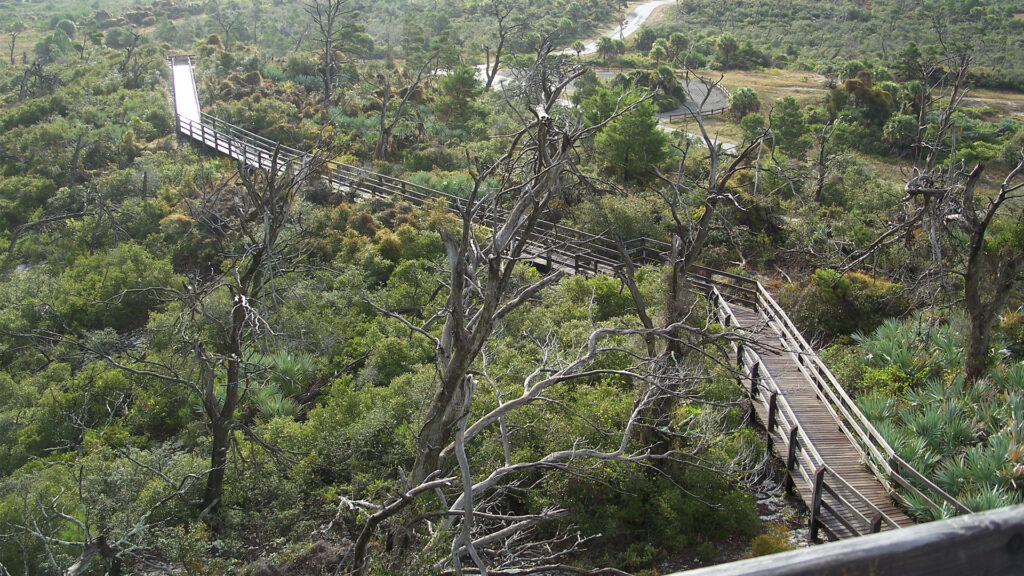By Haley Busch, 1000 Friends of Florida
Last summer, Floridians sent a clear message: Our state parks are not for sale. When officials proposed allowing commercial developments — golf courses, hotels and pickleball courts — within nine state parks, the backlash was immediate and overwhelming. Thanks to thousands of Floridians speaking out, the plan was scrapped. But the fact that it was even considered should serve as a wake-up call.
In response, state Sen. Gayle Harrell introduced SB 80, the “State Park Preservation Act,” and state Rep. John Snyder introduced a similar bill, HB 209, which are now moving through the legislative process. Their districts include Jonathan Dickinson State Park in Martin County, one of the nine sites proposed for development, where 1,500 acres of rare scrub habitat would have been converted into golf courses.

The “State Parks Preservation Act” would ensure that state parks are managed for “conservation-based public outdoor recreational uses,” which include fishing, camping, hiking and birding — but explicitly exclude sports requiring built facilities, like golf, tennis or pickleball. It allows small cabins (maximum six guests) while prohibiting large-scale lodges. It requires at least one public hearing with 30-day notice before any changes to park management plans.
These are welcome steps forward, and we thank Sen. Harrell and Rep. Snyder for their leadership in advancing them. Yet SB 80 must be strengthened to provide lasting protections. The bill still allows loopholes that could enable inappropriate development and does not extend protections to state forests and wildlife management areas.
Instead of repurposing public lands, Florida should focus on expanding conservation efforts and connecting existing protected lands within the Florida Wildlife Corridor — a statewide network of conservation lands critical for biodiversity, clean water and wildlife movement.
While significant progress has been made, more than 40% of the lands within the Wildlife Corridor remain unprotected and vulnerable to development. Rather than allowing new development pressures in our parks and conservation lands, the state should prioritize acquiring more land to close these gaps and strengthen Florida’s conservation network.
To provide additional long-term protections to SB 80/HB 209, lawmakers should:
- Apply protections to all conservation lands – State forests and wildlife management areas face the same risks as state parks and should receive equal safeguards.
- Clarify conservation intent – State parks and conservation lands should be explicitly designated for nature-based recreation and conservation, not altered for development.
- Remove language promoting development in “disturbed” areas – Many of these lands provide critical habitat and ecosystem benefits when restored and should not be prioritized for construction.
- Define rules for private development proposals – Loopholes in public-private partnerships allow private developers to propose projects on public lands. The bill should clarify what types of proposals are even eligible to prevent inappropriate development.
- Eliminate vague legal terms – Phrases like “to the maximum extent practicable” and “significant harm” create loopholes that could leave room for destructive activities.
- Explicitly prohibit harmful activities – Clearly listing prohibited activities will prevent misinterpretation and strengthen legal protections.

By making a good bill better, lawmakers can close loopholes, prevent future threats and ensure Florida’s public lands remain protected.
We recently helped draft a letter signed by at least 80 organizations proposing these critical improvements. You can reinforce these recommendations by contacting your state legislators today and urging them to strengthen SB 80/HB 209. Visit our website to send a message directly to your representatives.
On Feb. 11, the Senate Environment and Natural Resources Committee unanimously voted to advance the bill during an interim committee meeting. The bill still faces two more Senate committees, a full Senate vote and action in the House before it becomes law. That means there is still time to improve it – but only if Floridians raise their voices once again.
Our public lands belong to all of us, not developers looking for new real estate opportunities. The State Park Preservation Act is a good start, but it must be stronger.
Haley Busch is communications and outreach director for 1000 Friends of Florida, a statewide not-for-profit organization that focuses on saving special places and building better communities across our rapidly growing state. To find out more, visit www.1000fof.org. Banner photo: Jonathan Dickinson State Park (JMS Old Al, CC BY-SA 3.0, via Wikimedia Commons).
Sign up for The Invading Sea newsletter by visiting here. To support The Invading Sea, click here to make a donation. If you are interested in submitting an opinion piece to The Invading Sea, email Editor Nathan Crabbe at ncrabbe@fau.edu.



